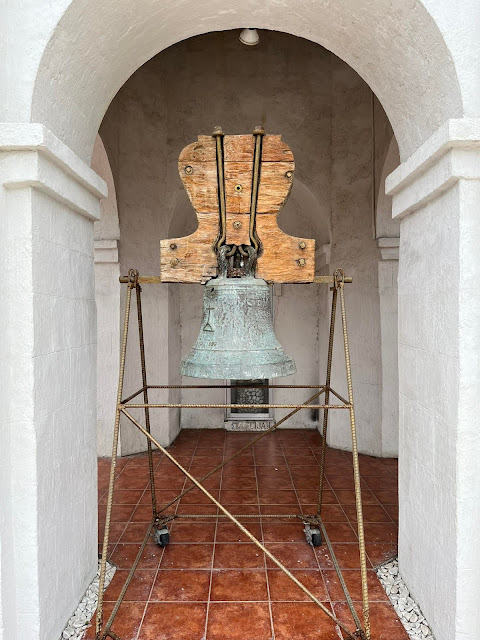 |
| La campana de vuelo, Talisay City, Cebu |
When I made a trip to Talisay City in Cebu last weekend, I made a quick visit to the Sta. Teresa de Avila Parish. As I was approaching the church, something caught my eye. In one of the side entrances, a lone church bell was displayed and it drew my attention.
 |
| the rusted clapper of the heritage church bell |
Based on its size and the wooden yoke attached to its crown, the bell can be described as a campana de vuelo. This type of bell rotates when rung by the campanero. Even before seeing the inscription, I knew it was aged because of the blue-green patina. The clapper is also covered with rust.
What was unusual about this bell is the lack of information found on the inscription. Usually, Spanish-era bells would be dedicated to a Patron Saint, will have the name of the parish priest or bishop, and will be dated.
This church bell only had a cross symbol (the difference in the cross design could be the maker's mark) and the date 1838 (Año D 1838) inscribed on it. The mystery of why it wasn't dedicated to Sta. Teresa de Avila or any other Saints may have been lost in history. Even who made this particular bell is unknown. I've tried searching for other books like Balaanong Bahandi and La Casa De Dios but to no avail.
 |
| Church bell dated 1838 |
Talisay was one of two haciendas owned by the Augustinians in Cebu. The other one was the Banilad Estate. It was a visita of San Nicolas until 1836 when Royal approval created the parish. Fr. Juan Soriano, the first parish priest, spearheaded the building of the church in 1836. It was finally completed by 1848. As with other Cebu churches, the main building material was cut-coral stones. The Spanish had a term for the stone and mortar combination that they used which is mamposteria.
 |
| Archdiocesan Shrine of Sta. Teresa de Avila |
The church has an entrance with a portico that we usually associate with the Greco-Roman design style. I don't normally see this type of church design here in Cebu. It has two bell towers flanking the facade. Not sure if there are more heritage bells found on those towers.
The building frontispiece has three medallions representing Sta. Teresa de Avila, the double-headed eagle of the Habsburgs (also an Augustinian symbol), and the Holy Trinity.
 |
| Facade medallions of Sta. Teresa de Avila Parish |
As with what normally befell our Heritage churches during the Spanish Colonial period, strong typhoons wreaked havoc on the church building. Galvanized iron replaced the roof's red tiles during the 1870s.
Unfortunately, during World War II, the church suffered extensive damage and was reconstructed in 1950 by then Father Teofilo Camomot who was the parish priest at that time. The now Venerable Teofilo Camomot became a bishop a few years after his time in Sta. Teresa de Avila.
This is also the only church named after Sta. Teresa de Avila or Sta. Teresa de Jesus in the country. Every October 15th, the feast day of Sta. Teresa is celebrated. In 2007, the parish was declared an Archdiocesan Shrine.
I hope someone will be able to share more facts about the centuries-old church bell(s) of Talisay.
Note: When I originally posted this on Facebook (The Visual Traveler Blog Page and Old Cebu Nostalgia Page), one reader shared a photo of a big bell dedicated to Sta. Teresa de Avila with a date in the 1800s (the year was not too clear) and recast in the 20th Century. Stan Cabigas, writer and photographer, commented that usually the biggest church bell is dedicated to the Patron Saint or the Holy Name of Jesus.
References:
Of War and Peace: Lantakas and Bells In Search of Foundries in the Philippines, Regalado Trota Jose, UST Publishing House, copyright 2009, reprinted 2014
Balaanong Bahandi Sacred Treasures of the Archdiocese of Cebu, The Cathedral Museum of Cebu and USC Press 2010
La Casa de Dios The Legacy of Filipino-Hispanic Churches in the Philippines, Fr. Rene B. Javella, SJ, Ortigas Foundation, Inc. 2010
Heritage Churches of the Cagayan River Basin, Javier Galvan Guijo, Vibal Foundation, Inc. 2022
Comments